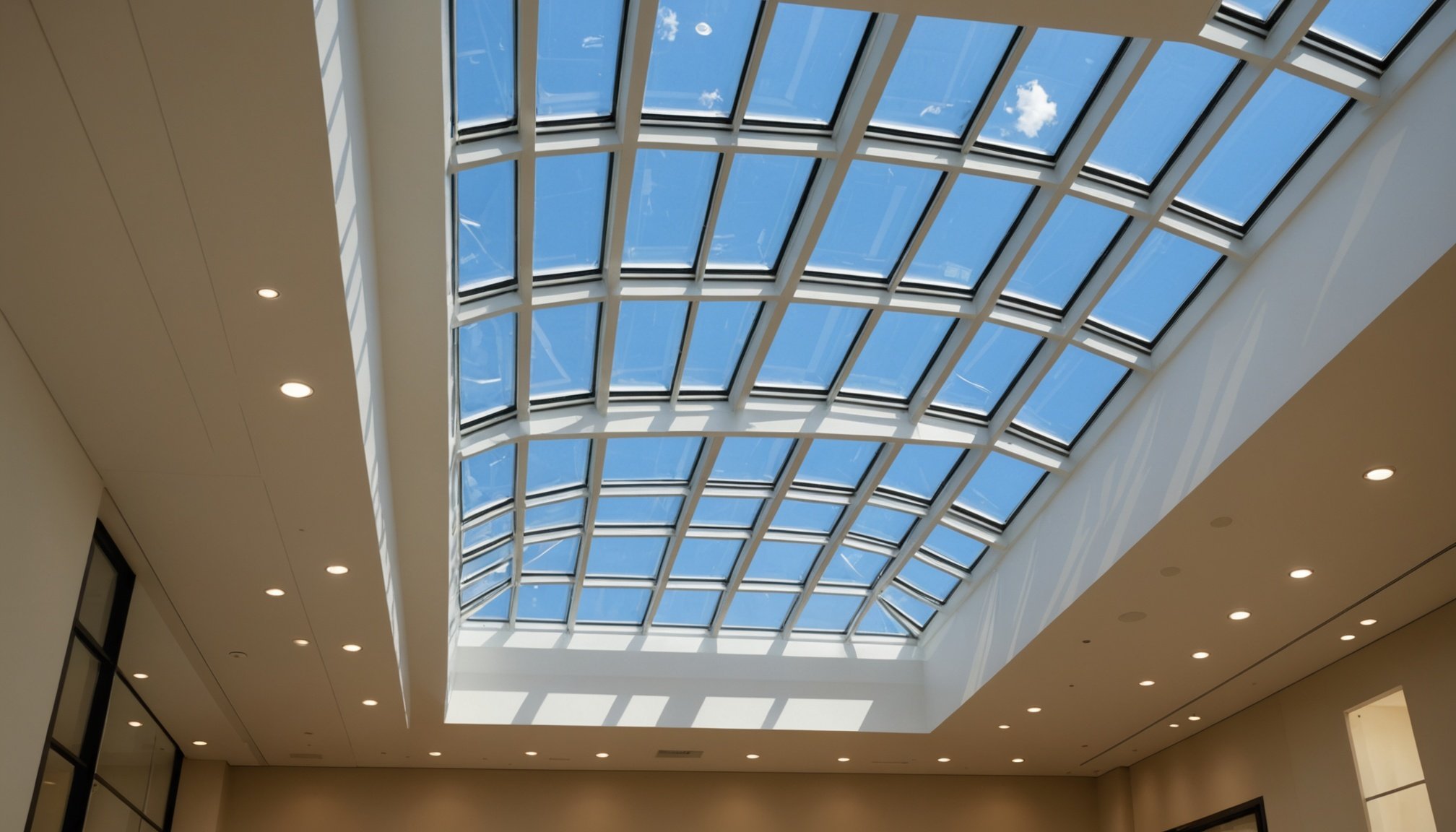Maximizing Natural Heat: Innovative Strategies for Effective Skylight Use
When it comes to enhancing the energy efficiency and comfort of your home or building, few elements are as versatile and beneficial as skylights. These roof windows not only bring in abundant natural light but can also play a crucial role in regulating indoor temperatures, reducing energy consumption, and boosting the overall energy performance of your space. Here’s a comprehensive guide on how to maximize natural heat using innovative skylight strategies.
The Role of Skylights in Energy Efficiency
Skylights are more than just a source of natural light; they are a key component in achieving energy efficiency in your home or building. By allowing sunlight to enter your space, skylights can significantly reduce the need for artificial lighting, which is a major contributor to energy consumption.
Also to read : Mastering the Art of Space: Ideal Designs for a Versatile Guest Room and Study
Reducing Artificial Lighting Reliance
“Skylight windows are transformative investments. The leading benefits of skylights include increased natural lighting exposure, which has been shown to enhance mood and productivity levels, and reduced artificial lighting reliance for decreased energy consumption,” notes an article from Consolidated Builders Supply.
Here are some ways skylights help in reducing artificial lighting:
This might interest you : Ultimate Guide to Effective Basement Waterproofing Techniques for Flood-Prone Regions
- Natural Light Distribution: Skylights capture and reflect sunlight into any space, ensuring even light distribution and minimizing the need for artificial lighting.
- Energy Savings: By reducing the reliance on artificial lighting, skylights help lower energy bills and contribute to overall energy savings.
- Enhanced Productivity: Natural light from skylights has been shown to improve mood and productivity, making it an excellent choice for both residential and commercial spaces.
Strategic Skylight Placement for Optimal Performance
The placement of skylights is crucial for maximizing their efficiency in regulating indoor temperatures and harnessing natural heat.
Understanding Sunlight Angles
In regions with distinct seasons, the angle and direction of sunlight play a significant role. For instance, in Toronto, north-facing skylights offer soft, consistent light without glare, while south-facing skylights provide direct sunlight that can be harnessed for warmth and brightness, especially in colder months.
Defining Specific Zones
When designing larger spaces, it’s essential to think about how to define specific zones within the area. Skylights can play a pivotal role in delineating these zones. By strategically placing skylights over central gathering areas or workstations, you can create distinct pockets of energy where natural light seamlessly supports the task at hand.
Here are some tips for strategic skylight placement:
- North-Facing Skylights: Ideal for offices or areas that require soft, consistent light without glare.
- South-Facing Skylights: Best for areas that need direct sunlight for warmth and brightness, especially in colder months.
- High Ceilings: Placing skylights in high ceilings or over communal spaces can reduce unwanted glare while maintaining the benefits of daylight.
Combining Skylights with Thermal Mass for Enhanced Efficiency
Thermal mass materials can significantly enhance the efficiency of your skylights by absorbing and releasing heat as needed.
Materials and Design Choices
Materials like rock, brick, concrete, and tile or stone flooring have high thermal conductivity, making them ideal for thermal mass applications.
- Fireplaces and Rock Walls: Surrounding fireplaces with materials like rock or brick and using interior rock or brick walls can add both aesthetic appeal and thermal mass. These materials absorb heat from the fire or sunlight during the day and release it slowly, helping maintain warmth even after the fire goes out or during cooler nighttime hours.
- Tile and Stone Flooring: Tile or stone flooring is a practical way to introduce thermal mass into your home. These materials absorb heat during the day and release it slowly in the evening, making your space more comfortable.
- Concrete Flooring: Polished concrete flooring has excellent thermal mass properties and is often found in energy-efficient home designs. Concrete floors store heat and release it over time, helping stabilize indoor temperatures.
Advanced Skylight Designs for Energy Efficiency
Modern skylight designs are engineered to maximize energy efficiency while providing aesthetic appeal.
Energy-Efficient Glazing and Insulation
- Low-E Coatings: Skylights with Low-E (low emissivity) coatings minimize heat transfer and reduce energy loss. These coatings help keep the heat in during winter and out during summer, enhancing the overall energy performance of your space.
- Insulated Skylights: Premium skylights feature superior-grade materials and advanced insulation properties to prevent heat loss and gain. This ensures that your space remains comfortable while reducing energy consumption.
Customization and Ventilation Options
- Operable Skylights: These skylights feature a hinged sash and can be opened for ventilation, allowing fresh air to enter and stale air to exit. This is particularly useful in warmer months to reduce the need for air conditioning.
- Retractable Skylights: These skylights sit on steel tracks and can be rolled open, providing excellent ventilation and natural light.
Maintenance and Installation for Long-Term Performance
Proper installation and maintenance are crucial for ensuring the long-term performance and energy efficiency of your skylights.
Installation Process
The installation of skylights should be carried out by professional installers to ensure that they are properly sealed and insulated. Here are some key points to consider:
- Professional Installation: Engage experienced installers to ensure seamless results that withstand the test of time.
- Minimal Disruption: The installation process can be carried out with minimal disruption to business or home operations.
Maintenance Strategies
Regular maintenance is essential to preserve the benefits of skylights:
- Routine Cleaning: Use non-abrasive cleaning agents to remove harmful build-up from the glass.
- Inspect and Address Wear: Regularly check and address symptoms of wear or damage to the skylights and their seals.
- Wipe Down Flashing and Seals: Inspect and wipe down flashing and seals to mitigate leaks and ensure optimal performance.
Case Studies: Successful Implementation of Skylight Strategies
Several buildings and projects have successfully implemented innovative skylight strategies to maximize natural heat and energy efficiency.
Langara Science & Technology Building
Located in Vancouver, this building employs a light well and a skylight on its west side to maximize natural light. The use of translucent polycarbonate wall panels and architectural screening helps diffuse daylight, reducing glare and enhancing the overall energy performance of the building.
Eugene Civic Park
Designed by Skylab Architecture, the fieldhouse in Eugene Civic Park features high, east-facing windows that maximize natural light admittance. The use of daylight sensors to control electrical lighting ensures that the courts can function with 100% natural lighting, enhancing supervision, safety, and energy efficiency.
Practical Insights and Actionable Advice
Here are some practical tips and actionable advice to help you maximize natural heat and energy efficiency using skylights:
Table: Comparing Skylight Types
| Skylight Type | Features | Benefits | Suitable For |
|---|---|---|---|
| Fixed Skylights | Non-operable, fixed position | Energy-efficient, low maintenance | Areas needing constant natural light |
| Operable Skylights | Can be opened for ventilation | Provides ventilation, reduces heat gain | Areas needing both light and ventilation |
| Retractable Skylights | Rolls open on steel tracks | Excellent ventilation, natural light | Large spaces, commercial buildings |
| Tubular Skylights | Uses reflective tubes to distribute light | Effective in cloudy days, minimal roof space required | Areas with limited roof space, residential homes |
| Low-E Skylights | Low emissivity coatings | Minimizes heat transfer, reduces energy loss | Energy-efficient homes, commercial spaces |
Detailed Bullet Point List: Benefits of Skylights
- Increased Natural Lighting: Skylights capture and reflect sunlight, reducing the need for artificial lighting and enhancing mood and productivity.
- Energy Savings: By reducing artificial lighting reliance, skylights help lower energy bills and contribute to overall energy savings.
- Enhanced Thermal Performance: Skylights combined with thermal mass materials can absorb and release heat, stabilizing indoor temperatures.
- Customization Options: Skylights come in various styles, including fixed, vented, and tubular, allowing for versatility and adaptability to different building types and specific needs.
- Improved Ventilation: Operable and retractable skylights provide excellent ventilation, reducing the need for air conditioning and improving indoor air quality.
- Increased Property Value: Skylights can increase the value of your property by enhancing the aesthetic appeal and energy efficiency of your space.
Skylights are a powerful tool in the quest for energy efficiency and comfort in both homes and buildings. By strategically placing skylights, combining them with thermal mass materials, and ensuring proper installation and maintenance, you can maximize natural heat and reduce energy consumption. Whether you are designing a new home, renovating an existing one, or enhancing a commercial space, incorporating skylights is a decision that will pay off in terms of energy savings, improved thermal performance, and a more pleasant living or working environment.
As Kori Chan, architect at Proscenium Architecture + Interiors Inc., noted, “The more natural light we can get to penetrate the building, the less ambient lighting we need to use, thereby reducing energy consumption. The challenge is controlling glare”. With the right strategies and designs, you can harness the full potential of skylights to create a more energy-efficient, comfortable, and inspiring space.










